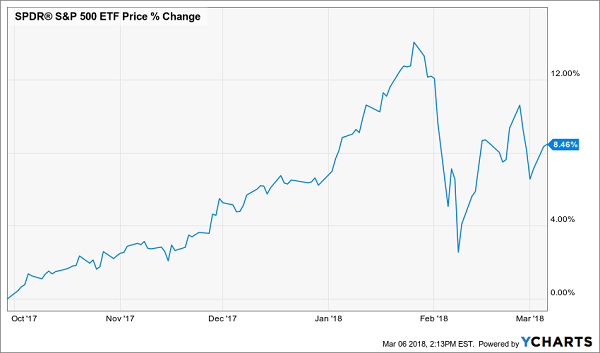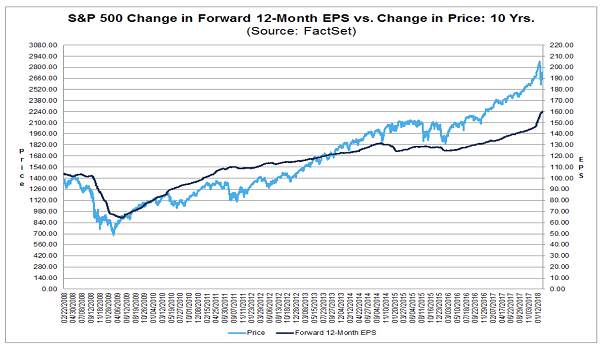I’m getting plenty of worried emails from readers, asking me if the near-10-year bull market in stocks is over and if it’s time to get out.
I give them the same answer every time: no.
Today I’m going to show you why—and reveal 2 unheralded funds that hold shares of the household names you know and love, but with two added twists: they give you a predictable shot at big gains in the next 12 months. And they do it while handing you an outsized average dividend yield of 11.3%!
That’s enough to hand you $942 a month in income (or $11,300 a year) on just a $100,000 investment!
I’ll have more to say about these 2 funds in a moment.
First, the reason why I say the bull market still has room to run is simple: there are too many reasons to be confident that stocks will rise, starting with insatiable demand for the products US companies are churning out.
In the fourth quarter of 2017, according to FactSet data, 78% of S&P 500 firms reported sales above their expectations. Total sales were up 8.2% at the end of the year. That’s why stocks have gained a handsome 8.5% since the start of the fourth quarter, even after the February selloff and recent volatility:
Some Bumps, But Still Upwards
The strong sales growth (which was actually higher than it’s been, on average, for the last seven years) is driven by one thing: the average American.
Admittedly, there are other good things driving strong sales (for instance, the lower dollar is pushing up US exports, which the rest of the world depends on regardless of the recently announced steel tariffs), but the bulk of S&P 500 companies still depend on Main Street America for their cash flow. And what’s happening on Main Street is very good.
The Bureau of Labor Statistics recently announced jobless claims have fallen yet again—reaching a (get this) 48-year low. That means a lot more people are working as a share of the US population than just a decade ago, following the financial crisis. And that, in turn, means more people are spending money on stuff made by American companies.
The Earnings Story
Companies are also handing those gains off to shareholders.
In the last three months of 2017, S&P 500 firms grew their earnings by 14.8%, the fastest rate since 2011 and far beyond the historical average. Companies are making more profits, which means US stocks should be going up at around the same rate as earnings are. If they don’t, stocks’ price-to-earnings ratios will fall and stocks will become cheaper than they used to be.
That’s what’s happening now.
Prices Go Down as Earnings Go Up
At the tail end of this chart, you can see the light blue line (the S&P 500 price) dip slightly while the dark blue line (the S&P 500’s earnings) rises substantially. As a result, the forward P/E ratio for the S&P 500 has fallen to 16.9.
It was over 20 just a couple months ago.
What does that mean? Stocks are on sale. In fact, one could call it a fire sale.
How to Get in—and Gain Financial Security
If now is the time to buy stocks, how should we do it?
One of the most popular ways is to buy an index fund like the SPDR S&P 500 (NYSE:SPY) and wait for the market to rise. If you do that, though, a $100,000 investment is going to get you a measly $149 per month in dividends.
There’s a better way: an off-the radar investment called a closed-end fund (CEF).
Consider, for example, the Sprott Focus Trust (NASDAQ:FUND), a Warren Buffett–style value-investing CEF with a conservative portfolio that includes Apple (NASDAQ:AAPL), Franklin Resources (NYSE:BEN) and Helmerich & Payne (NYSE:HP). Not only does FUND give you diversification across a range of sectors and well-known companies, but it also offers an 11.1% dividend yield, which means a $100,000 investment will deliver $925 per month in dividends.
That’s over 6 times as much cash income as SPY gets you.
Not only will you get the stocks in FUND’s portfolio, but you’ll get them at an 8.6% discount to their actual market price. That’s because the fund’s net asset value (NAV, or the liquidation value of its portfolio holdings) is 8.6% higher than the price you’d pay by purchasing this fund through a brokerage.
Welcome to the crazy world of closed-end funds.
But FUND isn’t the only one with this kind of income stream and discount.
In fact, there are dozens. Another particularly interesting one is the Liberty All Star Equity Closed Fund (NYSE:USA), which is almost entirely focused on big-cap stocks and has an impressive portfolio of household names, such as Google (NASDAQ:GOOGL), Facebook (NASDAQ:FB), Visa Inc (NYSE:V) and Amazon (NASDAQ:AMZN).
Oh, and did I mention USA’s 11.5% dividend yield, which gives you over $950 per month for a $100,000 investment? Not only that, but an investor in this fund has beaten the index by a wide margin over the last year:
Crushing the Market
With a chart like this, it’s hard to understand why the fund trades at a 9% discount. Outperformance, assets on sale and a big income stream? What’s not to love?
The MASSIVE Dividends Warren Buffett Would Love to Buy—But Can’t!
Are you sick of being left out while the big institutional players get the “inside track” on all the best opportunities?
Do you feel that the stock market is stacked against everyday investors like you?
Then let me show you something I know you’ll love: it’s a corner of the market the big guys would love to get in on but can’t—CEFs. In particular, I’m talking about CEFs with market caps around $1 billion or below, like the two I just showed you.
Think about it: if a big investment house with, say, a $20-billion market cap, bought every single share of a CEF with a $500-million market cap and that CEF doubled, it would only boost the buyer’s market cap by a measly 2.6%.
It’s just not worth the hassle!
No wonder Boaz Weinstein, a hedge fund manager who made a killing betting against the reckless trades of JP Morgan’s London Whale, called CEFs “a rare corner of the market where retail investors can get an edge over institutions.”
He also said: “One of the nicest points about this investment is that while you wait, you earn an above-average yield.”
I couldn’t have put it any better myself!
Disclosure: Brett Owens and Michael Foster are contrarian income investors who look for undervalued stocks/funds across the U.S. markets. Click here to learn how to profit from their strategies in the latest report, "7 Great Dividend Growth Stocks for a Secure Retirement."
